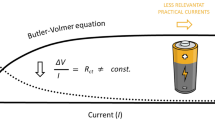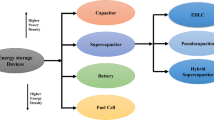Abstract
Our previously reported mathematical model for a mixed oxide nanoparticulate-based supercapacitor containing RuO2·xH2O and MO2·yH2O (M being another suitable transition metal) was analyzed. Both double-layer and faradaic processes responsible for charge/discharge were considered. The effects of the intrinsic factors, unit cell length, state of charge, and the exchange current densities of the electrochemical processes of the constituents on the performance of the model supercapacitor were clarified. Compensation effects where each constituent compensates the shortcomings of the other at specific conditions of discharge are analyzed in the light of the model.









Similar content being viewed by others
Abbreviations
- E :
-
Local electrode potential, V
- E 0 :
-
Initial local electrode potential, V
- \( \bar{E} \) :
-
Dimensionless local electrode potential, E/E 0
- h Ru :
-
Length of crystal lattice on the RuO2·xH2O surface, cm
- h M :
-
Length of crystal lattice on the MO2·yH2O surface, cm
- i 0,Ru :
-
Exchange current density for the faradaic reaction of RuO2·xH2O, A cm−2
- i 0,M :
-
Exchange current density for the faradaic reaction of MO2·yH2O, A cm−2
- i C :
-
Double-layer current per unit volume of electrode, A cm−3
- i cell :
-
Cell current density, A cm−2
- i f :
-
Faradaic current per unit volume of electrode, A cm−3
- \( {\bar{i}_C} \) :
-
Dimensionless double-layer current, i C L/i cell
- \( {\bar{i}_f} \) :
-
Dimensionless faradaic current, i f L/i cell
- L :
-
Thickness of the electrode, cm
- S V :
-
Specific surface area per unit volume of the electrode, cm2/cm3
- t :
-
Time, s
- t d :
-
Discharge time, s
- V 0 :
-
Initial potential before charge, 0.5 V (vs. SCE)
- x :
-
Position coordinate, cm
- X M :
-
Volume fraction of MO2·yH2O in the electrode
- δ Ru :
-
State of charge of RuO2·xH2O
- δ M :
-
State of charge of MO2·yH2O
- Φcell :
-
Cell potential or the matrix potential difference between the two current collectors, V
- \( {\bar{\Phi }_{cell}} \) :
-
Dimensionless cell potential, \( \frac{{{\Phi_{cell}}}}{{2{V_0}}} \)
- θ :
-
Fraction of oxidized species in the faradaic reaction
- ξ :
-
Dimensionless position coordinate, x/L
References
Farsi H, Gobal F (2009) J Solid State Electrochem 13:433
Farsi H, Gobal F (2007) J Solid State Electrochem 11:1085
Farsi H, Gobal F (2007) Comput Mater Sci 39:678
Rodrigues S, Munichandraiah N, Shukla AK (2000) J Power Sources 87:12
Blood PJ, Sotiropoulos S (2002) J Power Sources 110:96
Pop V, Bergveld HJ, Notten PHL, Op het Veld JHG, Regtien PPL (2009) Measurement 42:1131
Milocco RH, Castro BE (2009) J Power Sources 194:55
Zhongxue L, Jie C (2008) Microelectron Eng 85:1549
Tseng CY, Lin CF (2005) J Power Sources 147:282
Ng KS, Mooa CS, Chen YP, Hsieh YC (2009) Appl Energy 86:1506
Lee S, Kim J, Lee J, Cho BH (2008) J Power Sources 185:1367
Çadirci Y, Özkazanc Y (2004) J Power Sources 129:330
Hansen T, Wang CJ (2005) J Power Sources 141:351
Plett GL (2004) J Power Sources 134:252
Plett GL (2004) J Power Sources 134:262
Plett GL (2004) J Power Sources 134:277
Hammouche A, Karden E, De Doncker RW (2004) J Power Sources 127:105
Blanke H, Bohlen O, Buller S, Doncker RW, Fricke B, Hammouche A, Linzen D, Thele M, Sauer DU (2005) J Power Sources 144:418
Conway BE (1991) J Electrochem Soc 138:1539
Conway BE, Pell WG (2003) J Solid State Electrochem 7:637
Conway BE, Briss V, Wojtowicz J (1997) J Power Sources 66:1
Pell WG, Conway BE (1996) J Power Sources 63:255
Mahon PJ, Paul GL, Keshishian SM, Vassallo AM (2000) J Power Sources 91:68
Wakihara M, Yamamoto O (Eds) (1998) Lithium ion batteries—fundamentals and performance. Wiley–VCH, Weinheim
Shriram S, Renganathan NG, Ganesan M, Dhananjeyan MVT (2005) J Electroanal Chem 576:43
Lin C, Ritter JA, Popov BN, White RE (1999) J Electrochem Soc 146:3168
Jow TR, Zheng JP (1998) J Electrochem Soc 145:49
Author information
Authors and Affiliations
Corresponding author
Additional information
This paper has been presented in International Battery Materials Association (IBA) 2007 Conference, Shenzhen, China.
Rights and permissions
About this article
Cite this article
Farsi, H., Gobal, F. A mathematical model of nanoparticulate mixed oxide pseudocapacitors; part II: the effects of intrinsic factors. J Solid State Electrochem 15, 115–123 (2011). https://doi.org/10.1007/s10008-010-1072-2
Received:
Revised:
Accepted:
Published:
Issue Date:
DOI: https://doi.org/10.1007/s10008-010-1072-2




